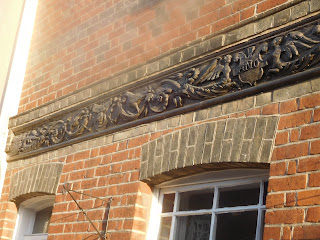Of fish bladders and boiled bones...
The 1861 census took place on 7th April. No one could have imagined that by December Prince Albert, the Prince Consort, would be dead at the age of 42, having suffered for several years with stomach problems. In Coggeshall, the silk industry was at its height - weaving silk and winding silk thread for use on the looms providing work for over seven hundred people.
A new industry had opened up in West Street after Mr Swinborne obtained a patent for isinglass production, setting up a new building alongside his tannery. Gelatine is a by-product of the tanning industry, made by boiling up bones and connective tissue. Isinglass is extracted from fish bladders. Imagine the odours in an industry like this! Both gelatine and isinglass can be used to refine beer and wine or to thicken desserts. The actual factory did not close until 1997, after which the building was converted into apartments.
East Street in 1861
There were 314 inhabitants in East Street, 111 of them aged 16 and under. For the first time lodgers become a feature of the street, with twenty-eight people described in this way. This may be the effect of workers from outlying villages being drawn in to work in the factories. for example, two silk throwsters lodging at "The Swan", one born in Sudbury and one in Halstead.
Also staying at "The Swan" that night was a group of four musicians from the East End of London. Where might they have performed and who would have made up the audience?
Women's Work
In 1861 eleven married women were recorded as working, as silk throwster, lace makers, laundresses or dressmakers. Perhaps that question simply was not asked in 1841. Only fourteen servants appear on the lists, twelve tambour lace makers and twelve dressmakers or milliners. The big increase is in factory work where both husband and wife might be velvet weavers, a highly skilled trade. Eighteen women and children were silk throwsters, winding the silk to prepare it for the looms.
Male Occupations
Traditional skilled trades continued to dominate male employment: saddler, cooper, basket.maker, gilder. However, there is evidence of business people expanding by adding trades: "butcher and farmer", for example, or "builder and brewer."Gas fitter" has been seen since 1841, but "gelatine worker" is new in East Street, reflecting the expansion of Swinborne's business in West Street.
Coggeshall in 1861 was a factory town, work in the silk-mills drawing in people from the outlying areas.

methinks Albert died of Typhoid
ReplyDelete